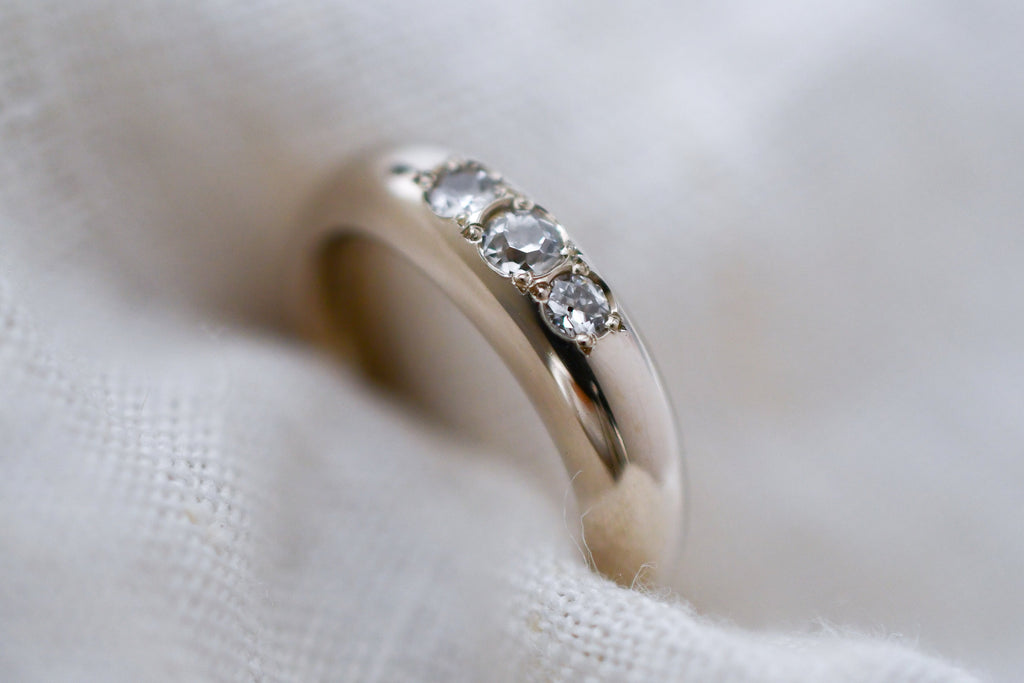What is white gold?
A beautiful, albeit somewhat complicated metal, we thought we would delve a bit more into what makes white gold a good option (or not) for you.
All gold used for jewellery is an alloy, which means it’s a mixture of pure gold and other metals. Pure gold (also known as 24-karat gold) is naturally yellow and far too soft to create wearable jewellery. The alloying metals lend their hardness as well as their colour to the pure gold. In the case of white gold, these are white metals like nickel, palladium, silver or zinc. The metals in the alloy not only lighten the colour but also make it stronger and more durable.

Even after it’s alloyed, white gold has a slightly warm, yellowish tint or a light grey undertone (depending on the particular composition of the alloy). To give it that bright, reflective shine people often associate with white gold, the jewellery is often plated with rhodium.
Rhodium is a rare, silvery-white metal that belongs to the platinum family and a micron thick plating gives white gold that crisp white look. With time however, rhodium plating will wear away revealing a yellowish, mottled tinge, and the ring will need replating to restore its lustre and radiance (every 12-18 months is a good rule of thumb).
Advantages of Rhodium plating:
- Bright, silvery-white shine and a modern, elegant look.
- Rhodium is naturally resistant to tarnishing, which helps maintain the shine of your jewellery in the short term (if the piece is made of a lower quality, predominately silver alloy, tarnish is not really an issue with palladium white gold alloys).
While rhodium-plated white gold is the most common choice for modern jewellery, unplated white gold has a unique appeal. Here at AuTerra we use a 10% palladium white gold alloy, giving our unplated white gold a creamy or champagne-like tone rather than the cool, bright white of rhodium-plated pieces. More and more people are embracing white gold’s natural colour and understated elegance, especially those who appreciate a slightly vintage or organic look in their jewellery.
Advantages of Unplated White Gold?
- Low-maintenance option: Since there’s no rhodium plating to wear off, you won’t need to worry about regular re-plating. This makes unplated white gold a practical, low-maintenance choice for everyday jewellery.
- Authentic, organic look: Many people love the natural beauty of unplated white gold because it has a warmer, more authentic appearance that ages gracefully over time. The slightly muted tone is also a wonderful complement to intricate details, textured finishes, or coloured gemstones.
- Sustainability and minimal processing: Unplated white gold requires less chemical processing and fewer resources than rhodium-plated versions.

The ingredients of the alloy matter!
Yellow and rose gold alloys tend to be fairly standardised across the industry but white gold alloys vary hugely. Nickel containing alloys can cause an allergic reaction and silver only alloys tend to be quite soft, suitable for pendants or earrings but definitely not ideal for wedding or engagement rings, as well as being susceptible to tarnish.
A high-quality white gold alloy will contain at least some palladium, which are the most durable and the closest to white in colour, but also the most expensive of the white gold alloys. So be prepared to pay a little more for high quality white gold than you would for the same piece in rose or yellow gold. Speaking of rose and yellow gold, it should be noted that white gold is slightly softer than its two, more coloured counterparts, so if you are very hard on your jewellery it may be better to stick with yellow or rose gold.
Whether rhodium plated or left in its natural state white gold can be a beautiful option for your heirloom jewellery.

